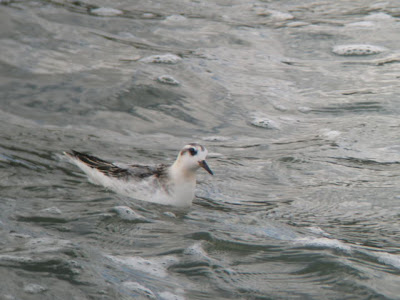October 27th: A day of overcast conditions, with light drizzle early morning and a light SE breeze, managed to produce a couple of nice surprises, with a
Pallas's Warbler and a very late
Wryneck both putting in an appearance at Holme. The Wryneck was first picked up in flight, dropping into the saltmarsh after flying from the sueada bushes below the paddocks, and later relocated feeding around the large patch of Sea buckthorn at the end of the golf course track. After showing well on the deck, it flew over the other side of the path towards Hunstanton and disappeared from sight. Given that there was noeone else around at the time its not that surprising that I was the only person to see it!
Convinced that there must be a Pallas's Warbler lurking somewhere nearby (how often do you find both Pallas's and Wryneck on the same day?!) I had just reached the Forestry when I received a call from my dad to say that he had just beaten me to the prize! Walking across the open dunes, I watched the unmistakable fluffball of green and yellow striped fly across in front of me and disappear into the cluster of Willows and Sea Buckthorn. After a short wait, it was relocated feeding in the Willows, where it remained for the afternoon. Thankfully it was still present the next day, where it gave good views feeding in the same trees in much better light.
October 28th: A relatively early start manage to produce an unexpectedly good seawatch off of Holme, with the following see on of Gore Point between 07:35 - 09:20
Red throated Diver
9W
2E
Black throated Diver 1WGN/BTDiver 1W
Fulmar
1W
Gannet
67W
12E
Wigeon
2W
Teal
1W
Common Scoter
56W
21E
Eider
2W
Goldeneye
1W
Red-breasted Merganser
11E
Great Skua
3W
1E
Arctic Skua
1W
1 lingering
Auk sp
7W
10E
Kittiwake
5w
3E
Little Gull Minimum
140W with 120 birds later seen in single scan. True figure likely in excess of
300 birds
November 5th: After a mornings ringing in the Coastal Park (a new pair of Bearded Tits being the highlight) we headed out to Holme for the afternoon, where I walked through along the beach from Hunstanton and across the sand bars opposite the end of the Golf course, around to Gore Point. A seawatch from the dunes at the base of the cliffs produced a steady passage of Kittiwakes, with groups heading North out of The Wash close inshore (65 birds in total) along with 16 Little Gulls and a Shag, later seen sat on the sea off of Gore Point. A Short eared Owl flew up from the Sand bars and the first of several mixed flocks of Blackbird, Redwing and Fieldfare came in high off the sea and dropped straight down into the bushes behind the dunes.
Shortly after leaving the forestry (where I had not seen a single other birder) I disturbed a small passerine from the brambles on the edge of the path, that flew a short distance and immediately dived straight back into cover. Though I had only been offered a fleeting glimpse with the naked eye, its small size, dull faintly grey brown upperparts, and distinctive call had me virtually convinced off its identity as a
Dusky Warbler. An anxious wait followed before it broke cover again, giving another tantalisingly brief flight view, but once again refusing to perch on the edge of the bushes. In total the bird was seen and heard by four observers that afternoon, but remained extremely elusive throughout its stay, feeding in typical Dusky fashion and staying hidden within the depths of the bushes. After a blank day Sunday it was heard and seen again on the Monday, but remained stubbornly quiet throughout the two hours that I spent waiting for it to show. A further two hours Tuesday morning proved equally fruitless...
November 6th : With a strong North wind blowing, I arrived at Holme before dawn with Connor and Billy, eagerly anticipating a long overdue autumn seawatch (I had only just seen my first Norfolk Great Skua the previous week!) Early signs for the day looked promising, with several thrushes seen along the entrance track in the headlights of the van, and several more heard calling around the car park and Observatory. Once the light had reached a stage of half decent visibility we headed out to the dunes where, between 06:40 - 08:10, we managed to record the following:
Red-throated Diver
4W
Gannet
51W
70E
Brent Goose
19W
Shelduck 245WPintail
4W
Wigeon
218W
Teal
42W
9E
Scaup 1W
Eider
7W
Common Scoter
120W
Velvet Scoter
3W
Red-breasted Merganser
3E
Great Skua
9w
Pomarine Skua 2WArctic Skua
3W
Little Gull
3W
Kittiwake
34W
19E
Razorbill
3W
Auk sp
24W
3E
Despite spending a couple of hours waiting around the patch of brambles that held the previous afternoons Dusky Warbler (a bird that I was more or less convinced would still be present in the morning) there was no sign throughout the day. Walking out to the far end of the dunes nearest Thornham channel, it was obvious that the morning movement of wildfowl had continued throughout the day, with groups of Teal and Wigeon still moving west close inshore. A 2 hour watch from 11:55 came up with the following:
Red-throated Diver
1W
1E
Gannet
24W
33E
Brent Goose
56W
Shelduck
46W
Mallard
6W
Wigeon
212W
Teal
238W
Pochard 6W
Eider 17W
Common Scoter
5W
Goldeneye
6W
Goosander 1WRed-breasted Merganser 7W
Dunlin
40W
Purple Sandpiper 1WGreat Skua 2W
Arctic Skua
1W
Kittiwake
6W


















































